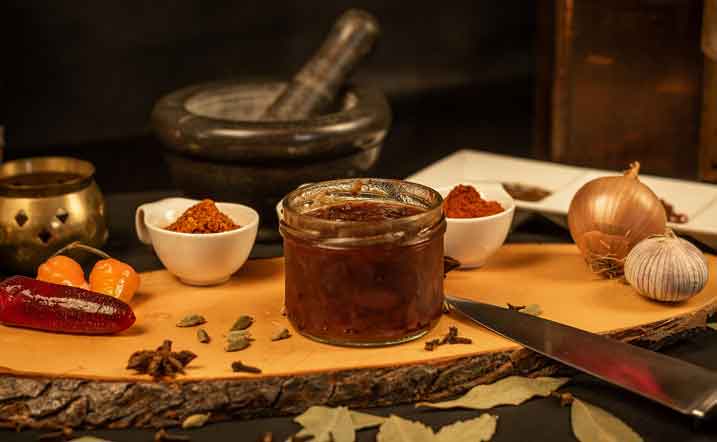
The History and Origin of Chutney
Hailing from the flavorful, spice-rich lands of India, chutney is a delicious and versatile condiment that can be used in a variety of cuisines.
It can come in the form of tomato relish, yogurt, curd, a ground peanut garnish, a mint dipping source, and much more. Here’s a quick overview of the history and origin of chutney.
Origin of the word “chutney”
The word ‘chutney’ derives from the Hindi word ‘chatni’, which is a variant of ‘chatna’, meaning ‘to lick’ or ‘to eat with appetite’.
The original use of chutneys can be dated back to 500 BC. The techniques used by those living on the Indian subcontinent to prepare pickles, which involve maturing them in the sun for two weeks, were applied to uncooked fruits (such as mangoes and apples).
Roman Influence
The fruits were then combined with spices and given an acid base (such as vinegar or tamarind juice), and… voila! Chutney was born.
Originally, the chutneys were intended to be consumed fresh within a couple of days of them being made. Later, methods would be found to preserve the chutney for longer.
This fruit-maturing technique was soon adopted by the Romans during their time in India (roughly 30 BC). The presence of the Romans in India is poorly documented, but it’s clear that the Romans were able to use their sprawling trade networks to deliver chutney to various corners of the world.
Overland caravan routes, which ran through Asia Minor and the Middle East, will have overseen the first deliverance of chutney to the western world.
British Colonial Popularity
Many, many years later, the British also took a particular fancy to chutney. In the 18th century, Britain had a significant colonial presence in India, and they quickly became infatuated with the many joys of Indian cuisine.
Chutney was among the most popular of condiments, and because the colonial powers were able to export it in large quantities to the west, it became very popular indeed in England.
The 1780s saw a huge surge in the consumption of chutney, with it being widely used in England as an appetizer.
The first branded bottles of chutney appeared in the west in the early 1800s. A British officer, known by history as Major Grey, had traveled to India for either work, pleasure, or both.
The story of Major Grey’s Chutney
The story goes that Major Grey simply couldn’t get enough of this delicious, exotic condiment, and thus hastened to bring it home to the west.
The recipe he procured would be labelled Major Grey’s Chutney, and it eventually found its way to the shores of America.
Major Grey’s chutney, it seems, has stood the test of time: in 1982, it was described as being the most popular type of chutney in the US. It is still mass produced today in the US and Canada. Curiously, it has never been sold in England.
Of course, the Major Grey recipe isn’t the only kind of chutney which successfully infiltrated the west.
Jarred chutney
Supermarket shelves are stacked full of delicious chutney, with mango chutney being a particularly popular accompaniment to curry dishes and even sandwiches.
Unlike their original incarnations, jarred chutneys are now able to enjoy a far longer shelf life thanks to the addition of preservatives.
So there’s a quick rap up of the history and origin of chutney. It’s been enjoyed for thousands of years, and will probably be enjoyed for thousands more!






